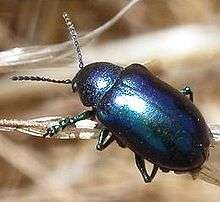Chrysochus
Chrysochus is a genus of leaf beetles in the subfamily Eumolpinae. It is known from North America, Europe and Asia.
| Chrysochus | |
|---|---|
 | |
| Chrysochus cobaltinus | |
| Scientific classification | |
| Kingdom: | Animalia |
| Phylum: | Arthropoda |
| Class: | Insecta |
| Order: | Coleoptera |
| Family: | Chrysomelidae |
| Subfamily: | Eumolpinae |
| Tribe: | Eumolpini |
| Genus: | Chrysochus Chevrolat in Dejean, 1836 |
| Type species | |
| Chrysomela praetiosa (= Chrysomela asclepiadea Pallas, 1773) Fabricius, 1792 | |
| Synonyms[1] | |
Nomenclature
The generic name Chrysochus Chevrolat in Dejean, 1836 is a conserved name. It was threatened by Eumolpus in the sense used by Kugelann in Illiger, 1798, which included Chrysomela praetiosa (now a junior synonym of Chrysochus asclepiadeus). An application to conserve Chrysochus and other names by suppressing Eumolpus Kugelann in Illiger, 1798 (modified to Illiger, 1798) was accepted by ICZN in 2012.[2][3]
Species
There are at least 12 described species in Chrysochus. Most of these are from the Palearctic and Oriental realms,[4] and two are from North America.
- Chrysochus asclepiadeus (Pallas, 1773)
- Chrysochus asclepiadeus asiaeminoris De Monte, 1948 (Considered a synonym by Ekiz et al. (2015)[5])
- Chrysochus auratus (Fabricius, 1775) – Dogbane beetle
- Chrysochus brevefasciatus Pic, 1934[6]
- Chrysochus chinensis Baly, 1859[7]
- Chrysochus cobaltinus LeConte, 1857 – Blue milkweed beetle
- Chrysochus globicollis Lefèvre, 1888
- Chrysochus goniostoma Weise, 1889
- Chrysochus hageni Jacoby, 1884[8]
- Chrysochus mniszechi Lefèvre, 1877[9]
- Chrysochus nilgiriensis Jacoby, 1908[10]
- Chrysochus pulcher Baly, 1864[11]
- Chrysochus sikhima Jacoby, 1908[10]
Biology
All species of Chryochus feed on plants in the Apocynaceae (dogbane) and Asclepiadaceae (milkweed) families. A small mutation has allowed the two North American species, C. auratus and C. cobaltinus, in particular to feed on the plant species containing cardenolides, while all other species of the genus feed on plant species without cardenolides.[12]
C. auratus and C. cobaltinus have been generally considered allopatric in distribution in North America. However, two narrow regions of sympatry between the two species have been documented in western North America, one of which is located in South-central Washington.[13]
References
- Bezděk, J. (2020). "Review of the genus-level names proposed by Johannes Gistel in Chrysomelidae (Coleoptera)". Acta Entomologica Musei Nationalis Pragae. 60 (1): 173–188. doi:10.37520/aemnp.2020.011.
- Moseyko, A.G.; Sprecher-Uebersax, E.; Löbl, I. (2010). "Case 3519 Eumolpus Weber, 1801, Chrysochus Chevrolat in Dejean, 1836 and Bromius Chevrolat in Dejean, 1836 (Insecta, Coleoptera, chrysomelidae): proposed conservation of usage". The Bulletin of Zoological Nomenclature. 67 (3): 218–224. doi:10.21805/bzn.v67i3.a10.
- ICZN (2012). "Opinion 2298 (Case 3519) Eumolpus Weber, 1801, Chrysochus Chevrolat in Dejean, 1836 and Bromius Chevrolat in Dejean, 1836 (Insecta, Coleoptera, chrysomelidae): usage conserved". The Bulletin of Zoological Nomenclature. 69 (2): 147–149. doi:10.21805/bzn.v69i2.a6.
The Commission has conserved the usage of the generic names Eumolpus Weber, 1801, Chrysochus Chevrolat in Dejean, 1836 and Bromius Chevrolat in Dejean, 1836 by suppressing the name Eumolpus Illiger, 1798.
- Moseyko, A. G.; Sprecher-Uebersax, E. (2010). "Eumolpinae". In Löbl, I.; Smetana, A. (eds.). Catalogue of Palaearctic Coleoptera. Volume 6. Chrysomeloidea. Stenstrup, Denmark: Apollo Books. pp. 619–643. ISBN 978-87-88757-84-2.
- Ekiz, A. N.; Şen, İ.; Gök, A.; Turantepe, E. (2015). "Occurrence of Chrysochus asclepiadeus (Pallas, 1773) (Coleoptera: Chrysomelidae) in Turkey: two distinct subspecies or the same taxon with slightly different populations?". Zoology in the Middle East. 61 (2): 148–152. doi:10.1080/09397140.2015.1020608.
- Pic, M. (1934). "Nouveautés diverses" (PDF). Mélanges Exotico–Entomologiques. 63: 1–36.
- Baly, J. S. (1859). "Descriptions of new genera and species of Phytophagous insects". Annals and Magazine of Natural History. 3. 4 (20): 124–128. doi:10.1080/00222935908697096.
- Jacoby, M. (1884). "Descriptions of new genera and species of phytophagous Coleoptera collected by Dr. B. Hagen at Serdang (East Sumatra)". Notes from the Leyden Museum. 6: 201–230.
- Lefèvre, E. (1877). "Descriptions de Coléoptères nouveaux ou peu connus de la Famille des Eumolpides (2e partie)". Annales de la Société Entomologique de France. 5. 7: 309–326.
- Jacoby, M. (1908). Bingham, C. T. (ed.). Coleoptera. Chrysomelidae. Vol. 1. The Fauna of British India, Including Ceylon and Burma. London: Taylor & Francis.
- Baly, J. S. (1864). Descriptions of new genera and species of Phytophaga. Stationer's Hall: J.S. Baly.
- Jolivet, Pierre; Verma, Krishna K. (2008). "Eumolpinae – a widely distributed and much diversified subfamily of leaf beetles (Coleoptera, Chrysomelidae)" (PDF). Terrestrial Arthropod Reviews. 1 (1): 3–37. doi:10.1163/187498308X345424.
- Peterson, M. A.; Dobler, S.; Holland, J.; T., L.; Locke, S. (2001). "Behavioral, Molecular, and Morphological Evidence for a Hybrid Zone Between Chrysochus auratus and C. cobaltinus (Coleoptera: Chrysomelidae)" (PDF). Annals of the Entomological Society of America. 94 (1): 1–10. doi:10.1603/0013-8746(2001)094[0001:BMAMEF]2.0.CO;2.
Further reading
- Dolgovskaya, M.Y.; Volkovitsh, M.G.; Reznik, S.Y.; et al. (2016). "Host specificity of Asian Chrysochus Chevr. in Dej. (Coleoptera, Chrysomelidae: Eumolpinae) and their potential use for biological control of invasive Vincetoxicum species". Entomological Review. 96 (7): 826–830. doi:10.1134/S0013873816070022.